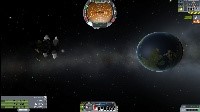Overview
This is a guide I have made to help people to get into geostationary orbits. For those who don’t know what a geostationary orbit is, it is basically an orbit that is the exact speed so that it always stays above a single area of the planet it is orbiting. I will add information for other planets and/or moons later.
What is a geostationary orbit?
A geostationary orbit is the term for a circular orbit that has the correct velocity and altitude to accurately have the same speed as the rotation of the celestial body that it is orbiting, and as a result stay above the exact same spot of the before said celestial body indefinitely.
This is a very useful orbit for both military satellites and commercial satellites that need to be in the same spot and not move around as that could cause holes in their coverage.
A geostationary orbit is not anything to really brag about but it is still a task that requires a fair bit of skill to achieve. If the orbit’s apoapsis and periapsis differ in altitude more than around 1km, it means that it will move a slight bit relative to the surface, but still be accurate. if it differs more than 10km, you need to adjust your orbit. this may take several burns, as you need a very exact orbital speed and altitude.
How to achieve a geostationary orbit.
At first, you do it exactly as a normal launch, but try to get an orbit at around 2.800km for a Kerbin Geostationary orbit. I found that i could get there with this craft and still have some fuel left for fine adjusting.

It should now look like this from map view (the highlighted orbit is the geostationary one)
Notes and important notes.
- [IMPORTANT] you will need to go in the same direction that the celestial body below you is rotating on its axis.
- some celestial bodies in the Kerbol universe may not have the sphere of influence needed to support a geostationary orbit. if you find the altitude for a geostationary orbit that is not listed in this guide, please put it in the comments and it will be added to the guide ASAP.
- a geostationary orbit has to be equatorial, if not, it will not be a geostationary orbit.
Geostationary orbit altitude list. (WIP)
Kerbin: 2 863.3 km
Duna: 2 880.00 km
Eve: 10 328.47 km
Jool: 15 010.46 km
Kerbol (A.K.A “The Sun” or “The Star”): 1 508 045.29 km
Minmus: 357.94 km
Eeloo: 683.69 km



